

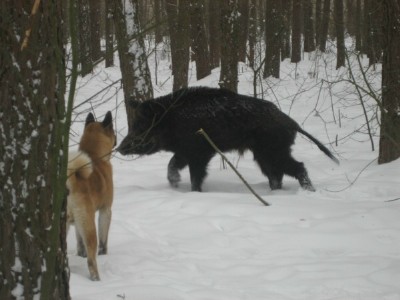
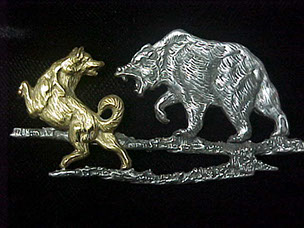
Historically, little is known about Japan, and even less is known about the history of the Akita. Japanese history, both verbal and written, describes the ancestors of the Akita Inu, the Matagi dog, as one of the oldest of the native dogs. The Akita Inu of today developed primarily from these dogs in the northernmost region of the island of Honshū in the Akita prefecture, thus providing the breed's name. The Matagi's quarry included elk, antelope, boar, and Asian black bear. This swift, agile, unswervingly tenacious precursor dog tracked large game and held it at bay until the hunters arrived to make the kill. (Right: Akita hunting boar in Europe photo courtesy of Chris Stanley of Moonlight Akitas)
Legend has it that 500 years ago, the Japanese equivalent of a Baron fell out of favor with the Emperor of Japan. He and his family were exiled to one of the outer isles of Japan. This island was overrun with Yezo Bear (a bear indigenous to Japan weighing up to 500 kilos). In order to deal with this problem, He decided to create a new breed of dog, combining, two types of wolf, an ancestor to the modern Mastiff, a Japanese spitz, as well as several other breeds. With this new massive breed of dog, he was able to eradicate the great Yezo Bear on the island. These giant dogs closely resemble the bears that they were bred to hunt. The black mask pinto Akita especially look like an adolescent Yezo bear, most likely this is not a coincidence.
Akita and bear jewelry
image courtesy of Golden Wonders Jewlery
Several years later the baron made a gift of many of these dogs to the Emperor. The Emperor was so taken with these dogs, not only did he give the Baron his land and position back, but he decreed from that day forth that each of his Samurai warriors was to keep his dogs. It is said that for five centuries this amazing dog became an integral part of Imperial Samurai culture, and only Emperor’s Samurai were allowed to keep them.
Whether or not they were bred by samurai, one thing is certain, they act like the samurai that may have bred them. They are fearless, and their loyalty is unparalleled.
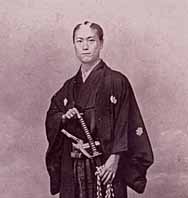
There is much controversy surrounding the modern history of the Akita.
At the turn of the 19th century, Emperor Taisho (pictured below with two of his dogs in 1899), who was particularly partial to these giant Akita, decreed that all Japanese, not just royalty could keep these dogs, making a gift of them to the Japanese people.
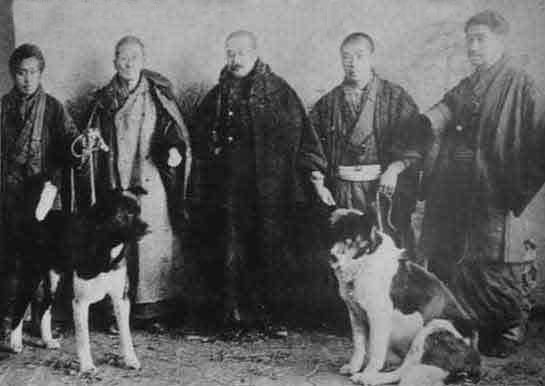
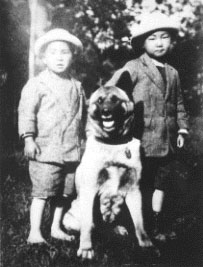
These dogs were so good with children that in the fishing villages of Japan mother and father would go fishing, and the Akita would stay home and care for the children, protecting them and preventing them from leaving the house. (Akita pictured left with two children, 1927).
Around the turn of the 20th century, two major events took a toll on the Akita population. Dog fighting was very popular in Odate province, this lead to the Akita being crossed with the Japanese fighting dog, the Tosa. This crossbreeding resulted in a dog of imposing size and aggression used extensively when dog fighting was a popular sport in Japan, and resulted in the deterioration of the classical types of traditional Japanese dogs.
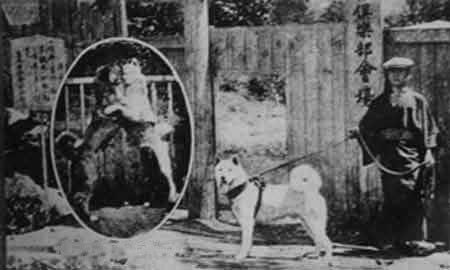
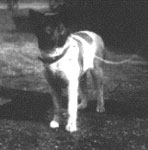
Dog fighting was so popular at the time that it became a social problem in the society of the time. There were organizations that organized large events and charged admission. It had become a booming business as a spectator sport and was eventually banned by the local government in 1909. Also, at the turn of the century, Japan had a fatal outbreak of rabies with more than 3000 cases reported. Dogs, both healthy and affected, were clubbed to death.
In 1914 the Emperor held an exhibition for Odate Inu dogs in Tokyo. After this exhibition, people in the Odate region began to see the damage that the dog importing was doing to the traditional breeds of Japanese dog. In fact The original strains of Odate Inu (the dogs that would later be known as the Akita) had all but disappeared. In 1915 the mayor of Odate started a movement to stop interbreeding and preserve the original strains of Japanese dog. This led to legislation being passed in 1919 to protect the Japanese Dogs in the province of Akita, and declare these dogs as a natural monument of Japan. This cause was championed by Dr Shozaburu Watase in 1920. It wasn't until 1931 that nine dogs were finally declared as natural monuments, found by a restoration team headed by Dr. Tokio Kaburagi. At this time new legislation was passed which named these dogs the Akita Inu for the first time.
In 1927 the Mayor of Odate City in the Akita Prefecture organized the Akita Inu Hozonkai (AKIHO) to preserve the original Akita as a national treasure through careful breeding. Nihonken Hozonkai (NIPPO) (society to preserve the original Japanese breeds) was established Tokyo in 1928. In 1931, the Akita was officially declared a Japanese Natural Monument.
On October 4, 1932 a true story, published in Asahi Shinbun (Asahi Newspaper), about the loyal dog Hachiko - one of the most revered Japanese Akitas of all time – touched the hearts of not only the fanciers but also Japanese people as a whole. The name Hachiko became known throughout the country and his breed, the Akita, was also brought into the limelight.
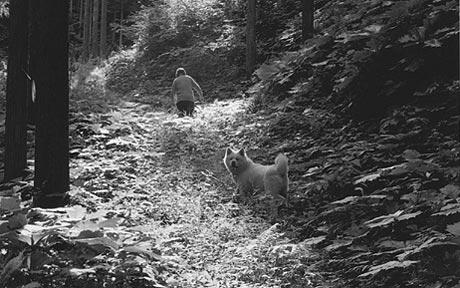
However, just as the breed was stabilizing in its native land, World War II pushed the Akita to the brink of extinction. Early in the war the dogs suffered from lack of nutritious food. Then many were killed to be eaten by the starving populace, and their pelts were used as clothing. Finally, the government ordered all remaining dogs to be killed on sight to prevent the spread of disease. The only way concerned owners could save their beloved Akitas was to turn them loose in the most remote mountain areas. There the breed's hardiness and keen hunting instincts helped them survive the war years.
There is a story told by many US veterans of World War II that when the American soldiers occupied Japan the Akitas came out of hiding from the hills of Japan and befriended the soldiers. Whether or not this is true, one thing is certain, the American soldiers smuggled hundreds of Akitas out of Japan upon their return to the US. It is these dogs which primarily became the foundation for the AKC Akita, also known as the American Akita. The Akita "Tachibana" (one of the very few purebred Akitas that survived World War II) was used on a Japanese postage stamp.
During the occupation years following the war, the breed began to thrive again through the efforts of many including Morie Sawataishi, (pictured below with his wife, 1940, and with his dog Shiro, who died in 1997 at the age of 15), whose story is told in Dog Man: An Uncommon Life on a Far Away Mountain by Martha Sherrill. For the first time, Akitas were bred for a standardized appearance. Akita fanciers in Japan began gathering and exhibiting the remaining Akitas and producing litters in order to restore the breed to sustainable numbers and to accentuate the original characteristics of the breed muddied by crosses to other breeds.

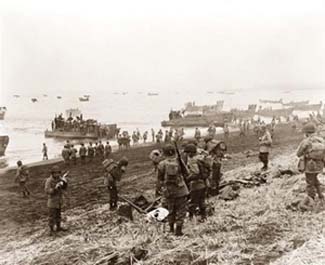
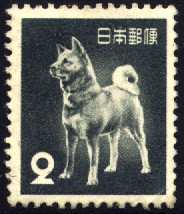
RIAR would like to thank Wikipedia, Emporer’s Akitas, Moonlight Akitas, Golden Wonders Jewelry,
and Hachimantai Kennel for facts and images.
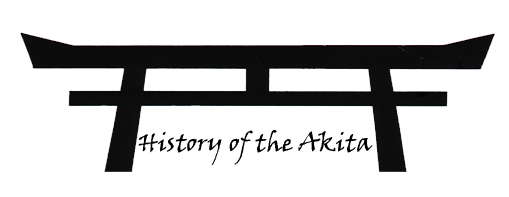
Copyright Rakki-Inu Akita Rescue 2018









